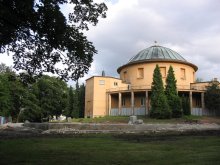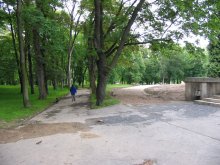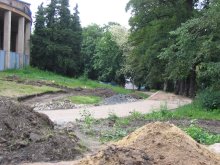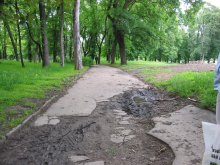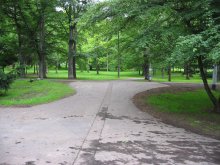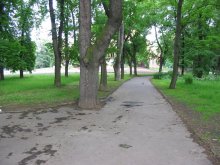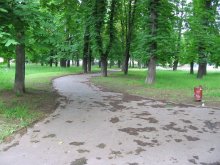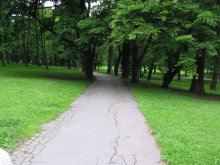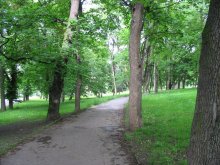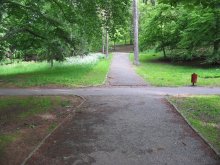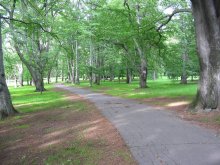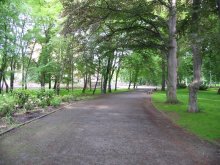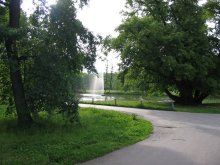Rules
robotika.cz outdoor challenge
To the occasion of the fifth anniversary of robotika.cz we have decided to organize a new competition for autonomous robots with a working name Robotour. It will be held in October 14th, 2006 in park Stromovka in Prague, Czech Republic. The goal of the robots will be to travel a given route of the park's passage ways. Emphasis will be on the robustness and reliability of the robots built with minimal expenses.
Motivation
Most of you have probably already heard about the
Grand Challenge competition, where
autonomous cars are supposed to travel a given path within a given time frame.
The Grand Challenge is very demanding, financially as well as from the robotic
point of view. There are very high requirements for reliability and robustness
of the whole system (remember, in 2004 none of the robots finished the route,
the best traveling only 7 miles). This makes the competition accessible only
to a very narrow group of people. Not only because of this reasons arose the
Mini
Grand Challenge with the goal of being much less demanding by allowing for
low cost (yet highly sophisticated) robots to compete. This idea caught us so
much that we have decided to organize a similar event here in Czech Republic.
Task
The task of the robot is to travel through the given route of the park's (paved)
passage ways. The route will be approximately 1 km long and the robot must
finish it within 1 hour time limit.
The route will be given using a road network (RNDF - Road Network Definition
File) and with several checkpoints (MDF - Mission Definition File) using the
same coding as
route
specification for DARPA Urban Challenge. The network data will be available
at least one month before the contest and it will contain all possible allowed
paths. The list of checkpoints will be given to teams one day before the
contest (in DARPA Urban Challenge it is planned to be only 5 minutes before the
start). The specification of files is in the appendix.
Note: Although the route is given in the absolute WGS84 coordinates, the robot
does not have to be equipped with GPS receiver! It is possible, for example,
to generate an approximate map of park Stromovka and the route can be manually
compiled into commands like in 25 meters turn right, on the next junction
continue ahead, ... Moreover the team can walkthrough the route the day
before contest.
The route is selected form park's passage ways. If the robot leaves the road,
it will be paused, returned on the road and if a responsible person from the team
agrees, the robot may continue with penalty points. The best result counts and
all sucessfully finished rounds are summed up (see Evaluation). Maximum speed of
the robot is limited to 2.5m/s (corresponds to a faster walk).
Minimal average speed is given by the time-limit and the length of the route.
Also immobility of the robot lasting more than 60 second is a reason for
termination of the attempt to finish the route. The current position on the
route will be taken into selection of the best trial.
Robot
The robot must be fully autonomous. After the start no communication with
the outside world is allowed. The robot must be equipped by an easily accessible
big red STOP button. Remote switch is not needed because of the maximum speed
allowed. Two people must be able to lift the robot and carry it several tens
of meters.
Finally the robot must be able to carry a payload — the Czech variant of the
payload is a five litre beer barrel filled with water (the original filling
will be saved for a later use). [Because payload could be too limiting in this
limited time remaining to contest, payload won't be mandatory in the first
year. Robots able to carry payload the whole route will get extra points. ]
There are no constraints on the size of the robot. However the size
is limited implicitly by the payload (minimum size) and by the width of the
passage ways (maximum size). The robot must be electrically powered, no other
power is allowed.
The robots should not have any protruding or sharp parts that may be able to
inflict damage or that can be dangerous. The use of liquid products, corrosive
products, pyrotechnics materials or living beings is forbidden. All the
systems taken aboard the robots, shall respect the law. Specifically, the
systems used shall comply with legal safety regulations and must not endanger
the participants or the public.
All robots must comply with the legal standards concerning “low voltage”.
Therefore, the internal voltage of the robots shall not exceed 48 V.
Every robot will be followed by one person from the team, older then 18, who is
completely responsible for the robot behavior. In the case of unexpected
behavior this person must use PAUSE or STOP button (see further below).
Date and Place
The contest will take place in October 14th, 2006 from 10 to 17 hours in
Prague's park Stromovka. In case of a very bad weather the contest may be
postponed to Sunday or even to the following weekend.
Homologation and Contest
Similarly to the Eurobot contest the robot must first go through the process of
homologation. Besides checking all the requirements set forward by these rules
the ability of the robot to finish the route will be also checked. To compete
the robot must be able to travel 10 meters on a straight passage way within 5
minutes. Each team will have several trials.
RoboTour 2006 will be one-day-contest, but the teams expected arrival is one
day before the contest. In the morning (or potentialy already after teams
arrival) the robot will be homologated and the fixed order of teams will be
given. There will be 5 competition rounds. Note, that there could be several
robots competing simultaneously. The start time interval will be at least 10
minutes, and it will depend on the final number of homologated robots.
If the team will not be ready in time given by schedule, the time-slot will remain
unused. Thus every team will know when exactly has to be ready.
Evaluation
The contest wins the team, whose robot will manage the route the best. All
finished rounds are counted plus the best unfinished trial. It is possible to
get double points for completed route, if the robot will carry extra payload.
The robot will not any get extra points for unfinished case.
PAUSE button
Every robot has to be equipped with PAUSE button, which temporarely pauses
robot motion. After re-activation (a normal switch could be used too) robot may
continue on the road. The PAUSE button will be for example used when the robots
will get closer than 10 meters apart. This functionaly will be tested during
homologation procedure.
Registration
If you find the rules of this contest interesting and would like to participate
let us know using our contact form. The
registration deadline is the September 14th, 2006.
Sponsors
There is no clear first prize (you know, none of us has left over $1M).
However there are still the original fillings from the payloads . In any
case if there is anyone who would like to offer anything more, do not hesitate
to contact us too.
Appendix
This is a short overview based on
detailed RNDF and
MDF format specification.
RNDF format specification
RNDF — Road Network Definition File describes all allowed roads and travel
zones. The network is composed of segments, where each segment can have several
lanes. Lane is then list of coordinates (latitude and longitude in WGS84
system).
Every point (waypoint) has unique identification. For example waypoint 7.2.3
belongs to segment 7, lane 2 and it is 3. in order. Lanes are oriented and
their points have to be passed in order. There are some special waypoints:
- exit <from><to> … describes link beween waypoints of different lanes/segments
- check_point <checkpoint id> <order>… checkpoint, later used in MDF
Here is an example of RNDF:
RNDF_file stromovka num_segments 30 num_zones 0 creation_date 17.6.2006 segment 1 num_lanes 1 lane 1.1 num_waypoints 10 lane_width 5 check_point 1.1.2 1 exit 1.1.10 2.1.1 exit 1.1.10 3.1.1 1.1.1 50.063171 14.256622 1.1.2 50.063141 14.255622 … end_lane end_segment segment 2 num_lanes 2 lane 2.1 … end_file
MDF format specification
MDF - Mission Definition File describes mission, i.e. where robot has to
go. It is mainly sequence of checkpoints. MDF contains also maximal speed, but
this information is irrelevant in RoboTour2006 contest.
An example of MDF:
MDF_file robotour06 RNDF stromovka checkpoints num_checkpoints 3 checkpoint_id 3 checkpoint_id 143 checkpoint_id 32 end_checkpoints speed_limits num_speed_limits 0 end_speed_limits end_file



